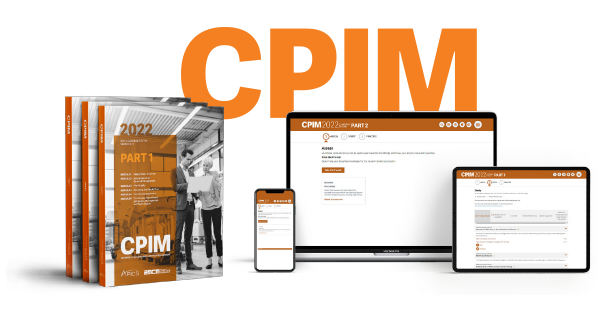In the supply chain industry, the efficient use of resources and management of streamlined processes are what separates successful organizations from the status quo. Any opportunity to enhance critical processes and reduce waste should be pursued and falls under the proverbial umbrella of lean manufacturing. This concept revolves around — and always comes back to — five essential lean manufacturing principles that, when embraced by a supply chain organization, can lead to optimal inventory management and indeed optimal overall management of an organization's supply chain operations.

At its core, lean manufacturing is focused on improving efficiency while reducing waste, both of which need to occur in order for an organization to be highly successful. As such, there are five key principles that characterize lean manufacturing:
Determine the value expected and desired by the customer through meaningful interaction and develop a strategy to bring the relationship between value and price closer. Organizations need to have a firm understanding of their customers' expectations in order to serve them with the highest level of value. In most cases, customers are focused on receiving a specific amount of value that coincides with the price of a given product, and by eliminating wasteful practices, it’s possible to leverage lean manufacturing principles to increase value while providing the best possible price.
Identify the value stream for the products that provide the value that customers are looking for and determine how to reduce or eliminate waste along each stage of the stream. After reviewing the complete life cycle of a given product, supply chain organizations need to be able to identify areas where improvements can be made and where waste can be reduced. Each stage of the process — from design and manufacturing to fulfillment, delivery and disposal — should be mapped and analyzed to determine weak points that can be improved. The rule of thumb here is that if it doesn't add value to the customer, it doesn't belong in the value stream.
Develop a method of ensuring a continuous flow of manufacturing and fulfillment so that products are produced at or near the same rate that they are required. The modern-day flow principle pays homage to Toyota's just in time system where organizations plan their strategy by accurately forecasting both demand and supply so that manufacturing can be placed on cruise control. A significant source of waste is the disruption of manufacturing due to inaccurate supply and demand planning where organizations suddenly have either too much inventory or too little, leading manufacturing processes to stop abruptly and then ramp back up quickly.
Establish a pull system that eliminates waste by only triggering the production of items when there is demand for them. Pull systems work to eliminate waste at each stage of the process, but only when the appropriate planning is initiated as part of a comprehensive strategy. If the production of goods only commences when there is demand, the organization needs to ensure that they are able to accurately forecast demand so that manufacturing never actually stops but instead stays constant throughout demand ups and downs. That said, there needs to be a good balance, as too much supply and not enough demand can lead to costly warehousing fees — in other words, more waste and less value delivered to customers.
Analyze metrics constantly so that areas of improvement can be easily identified in the pursuit of enhancing the customer experience. In a perfect world, the number of steps in the product life cycle would continue to decline, as would the time, information and resources that are required to bring products to end users. By collecting and analyzing data from various sources, organizations can eliminate weak links and create a far more streamlined process that enhances the value for customers and reduces both cost and waste along the way. Perfection is perhaps unattainable in a literal sense, but there is always room for additional improvement.
From raw material deliveries and waste removal to inefficient supply chain logistics, unnecessary transportation represents a significant amount of waste that can detract from the value of the product by adding excess costs. Without a solid strategy in place for keeping manufacturing consistent, half-loaded trucks and multiple uncoordinated deliveries lead to higher costs and contribute to an overall inefficient use of both human and material resources.

Storing excess inventory comes at a cost, especially if the organization itself isn't equipped to house a surplus. This issue is most often a result of poor demand planning and in turn, the organization might have to sacrifice the ability to store other products that do carry a current demand. The disruption may then continue to spiral, affecting the manufacturing process and causing production to cease while the organization scrambles to offload excess stock.

Products should be handled as little as possible to avoid wasted time, energy and machinery use. Disruptions to the supply chain process are evident when there is a lack of coordination within the value stream, and this can cause a ripple effect of waste production at all other stages of the supply chain process.

Idle time, whether in regard to production or lack of employee direction, causes disruptions that can add excess costs. As organizations adopt and implement lean manufacturing principles, they need to be constantly aware of opportunities to tighten up so that employees understand what is required of them and have the tools and resources available to act on their responsibilities. Machines can't sit idly by either, and by combining effective supply and demand planning with evaluation at each stage of the value stream, this idle time can be reduced (if not eliminated entirely).

Overproducing products is a sign of poor demand planning and one that needs to be addressed post haste. If overproduction occurs as a result of inaccuracies and inconsistencies in demand forecasting it can lead to warehousing and storage problems that stray from sound inventory management best practices. Again, proper planning can help to reduce the risk of overproduction and keep products moving more consistently so that there is always room for new inventory.

Strategic planning and design are essential to the success of consumer products and that includes forethought in terms of how the products are manufactured. Defects can be costly as both raw materials and finished products are wasted when they cannot be sold. This adds cost, leads to increased customer returns and destroys perceived value.

Waste isn't always obvious, and it can easily go undetected if an organization isn't constantly striving for perfection. If qualified individuals aren't assigned tasks that match their skillsets it could mean that talent is being wasted instead of being used to further tighten up core processes. The same goes for ingenuity. There may be more efficient methods of achieving organizational goals related to inventory management and lean manufacturing that go unexplored if managers are not aware of the knowledge and capabilities of their team members. This is why constant communication is important as the more data available, the better and more tailored the solutions can be.

Following lean manufacturing principles can lead to numerous benefits that can help organizations ensure the future success of their operations, but positive growth always requires a degree of discomfort. As such, there are both advantages and disadvantages to implementing a lean manufacturing strategy.
Lean manufacturing saves money and safeguards time. Better management and allocation of resources improves efficiency and as a result, lowers the cost of doing business. Serving customers faster with better products thanks to a coherent value stream is a positive outcome of lean manufacturing and perhaps the greatest advantage available.
Lean manufacturing is environmentally sustainable. Manufacturing efficiency can help reduce the strain that production places on the environment. This is why constantly analyzing and modeling data is so important, as organizations can identify ways to limit their consumption of energy, raw materials and more.
Lean manufacturing produces satisfied customers. Lean strategies lead to enhanced customer satisfaction as organizations are able to increase the value while keeping their prices low. The happier customers are, the more likely they are to purchase repeatedly, leave positive reviews and recommend to their friends, families and colleagues.

Potential to negatively affect employees. Organizations must be careful not to cut too much in the pursuit of reducing waste and improving quality. Employee wellbeing must be considered, else the organization runs the risk of experiencing deteriorating quality due to employee burnout.
Reducing for the current situation might have a negative effect on future endeavors. If an organization is too focused on cutting waste, it may not see the broader picture of future needs. Eliminating what are thought to be inefficiencies today could be a costly mistake without a long-term strategy in place.
Standardization can be a roadblock. Each organization may need to tailor its initiatives to suit specific operations which can lead them away from developing a standard model for lean manufacturing. This has the potential to create problems down the line.

Organizations looking to improve their processes to incorporate lean manufacturing should first look to technology and training. Using purpose-built enterprise resources planning software to track inventory waste can help advance supply and demand planning. In addition, achieving ASCM’s Certified in Planning and Inventory Management (CPIM) designation can help supply chain professionals better understand the nuances of inventory management and develop ways to optimize and streamline processes accordingly.

With the help of ASCM education, Ingersoll Rand implemented an enterprise sales inventory operations planning and materials management strategy that enabled the company to make materials management a core competency within their organization. Through valuable training and education via the ASCM CPIM program, Ingersoll Rand created a push-pull system that leveraged organizational design and lean manufacturing principles.